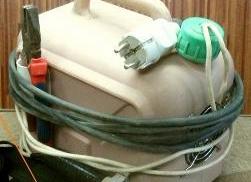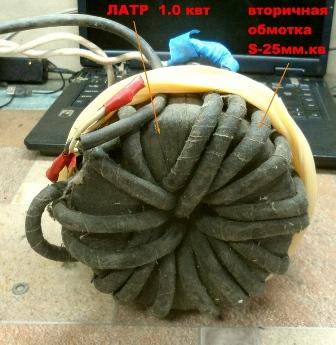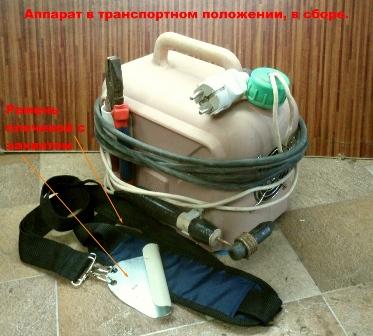Categories: Featured Articles » Sharing experience
Number of views: 30,229
Comments on the article: 9
Wire welding transformer
 I suggest that you familiarize yourself with the design of a welding transformer for mounting junction boxes. I have been using this transformer for a long time, but finally I decided to improve it a bit and make it more convenient to use. To do this, he returned the transformer to its original state and started working, fixing it in the photo.
I suggest that you familiarize yourself with the design of a welding transformer for mounting junction boxes. I have been using this transformer for a long time, but finally I decided to improve it a bit and make it more convenient to use. To do this, he returned the transformer to its original state and started working, fixing it in the photo.
So, I have a toroidal transformer from LATR, P = 1.0 kw. One core was taken as a secondary winding stranded cable KVNG 4x35mm.kv., From which the "native" insulation was removed and two layers of cotton tape were applied. The total diameter of the wire is significantly reduced, and the quality of the insulation remains acceptable.
This was done due to the small window of the torus. The secondary winding is wound until the window is full. Output voltage = 15.6 v. For reliability, the winding is fixed with a silicone ring twisted with an “interference fit” in several layers. But this is reinsurance (at high currents, the movement of wires and damage to the cotton insulation is possible). Connecting wires twisted. For several years of operation, the contact did not deteriorate, so he did not redo it.



The first thing I decided on the case. The old case, made of a small canister, "got" me with an uncomfortable shape (square) and an uncomfortable handle (under three fingers). The new building decided to do the same from a canister (pluses - insulation, stiffness, does not require painting), but rectangular in plan, shape.
Having determined the height, he cut off the excess and made a plywood base (s-8mm). To the bottom base attached legs made of bottle caps.



On the base I attached a transformer, a diode bridge, as well as connecting wires. I cut two windows in the canister case, one under the computer cooler, the other on the opposite side, for air intake. The cooler should “throw out” the heated air out. Since the cooler was modding, the power indicator was not needed.
Since the hull was cut off in height with a “margin”, the excess was enough to make “ears”, which were wrapped under the bottom and screwed them with plywood to the plywood (in the old version, it was screwed into the end of the plywood, and due to the considerable weight, the plywood broke periodically).

The charcoal holder is made of 10 mm monowire2, diameter 3.5mm. The coils of the spring are wound on a blank whose diameter is slightly smaller than the diameter of the coal. Having screwed coal into such a spiral, we get reliable contact. A wooden handle is put on the flat end of the wire with an effort, at the end of which there is a hole of a larger diameter (there the “soldering” of the mono-conductor with a flexible stranded wire “hides”). Pliers perform the role of clamping and heat removal during cooling of the twist. They are connected to the wire by winding the wire onto the handle and then crimping the insulating nozzle.
For pliers, a plastic loop is made on the case, and a “clip” for a 20 plastic pipe came up for the coal holder.
Welding wires were shortened by the house 1.5m. Therefore, the apparatus itself must now be placed “on a suspension” during operation, for which it made a grip in which the handle of the apparatus is conveniently located.

The grip itself is a continuation of the belt, which is hung on the shoulder, over the head. Thanks to the grip, the device is easy to manipulate without removing the belt.
See also at bgv.electricianexp.com
:




